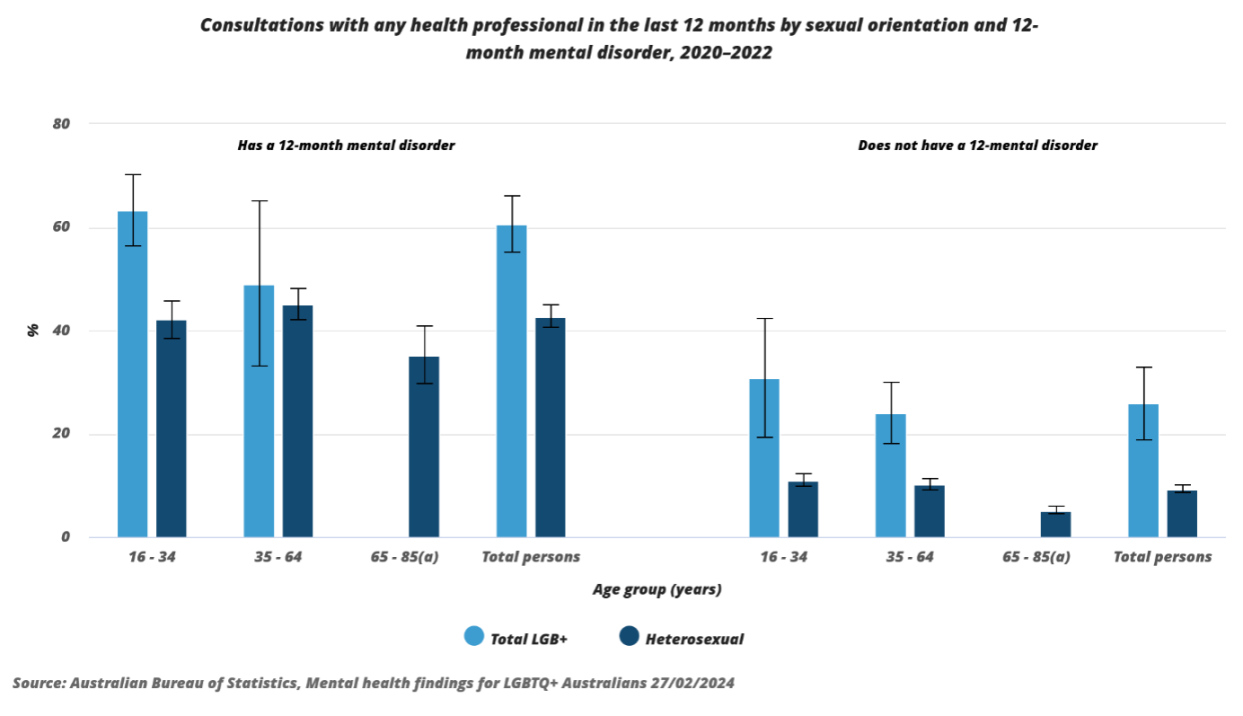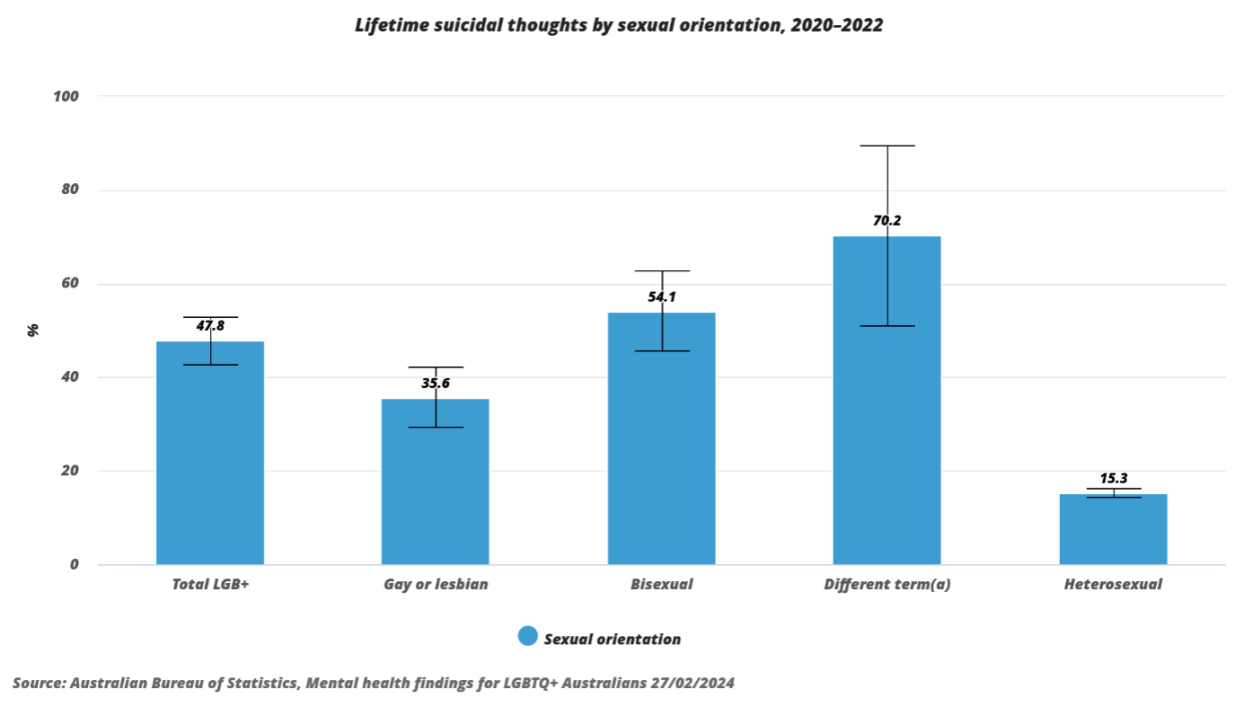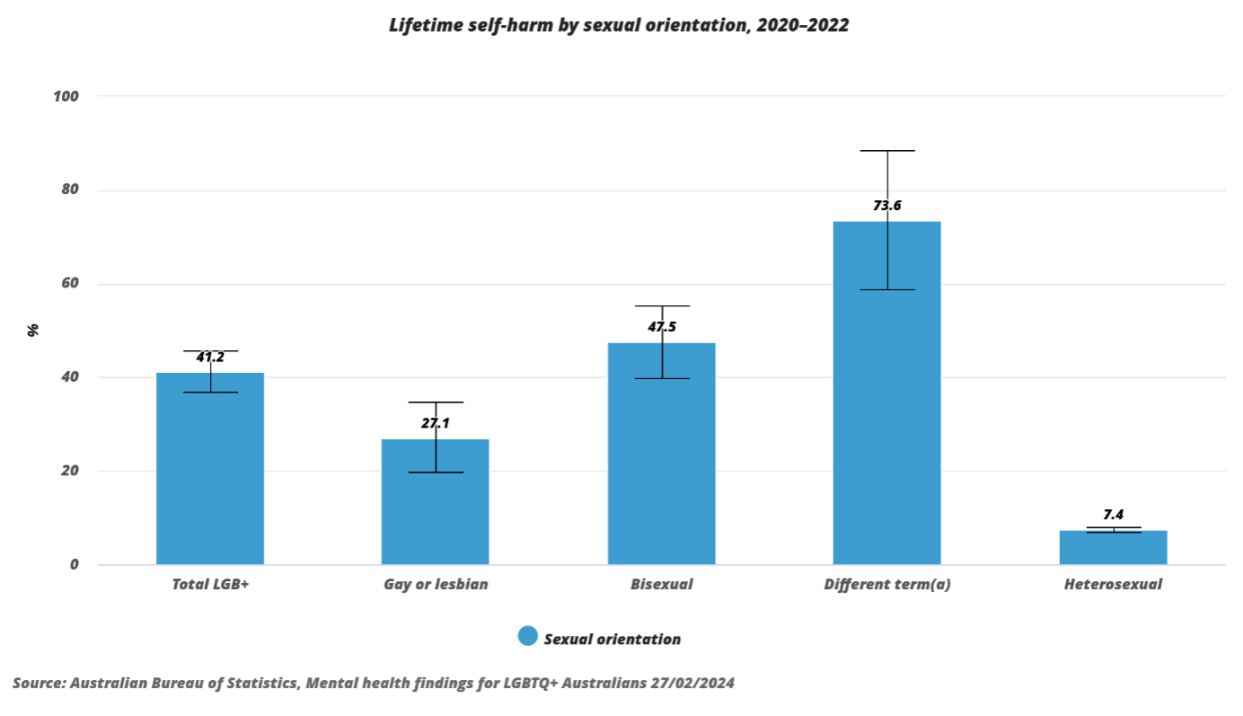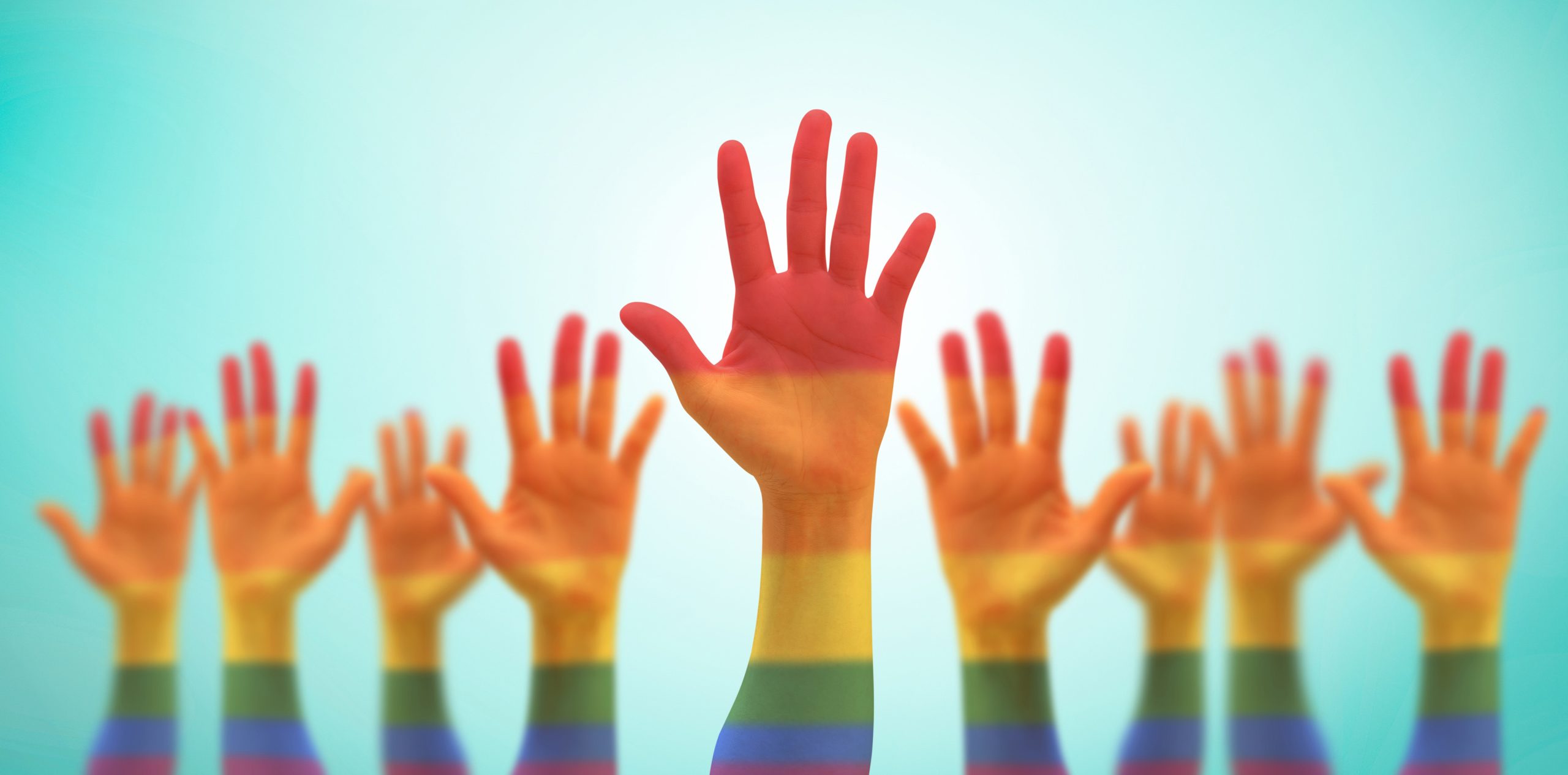Almost half of all queer people have seriously thought about taking their own life, compared with just one in seven heterosexuals.
New data from the National Mental Health and Wellbeing Survey, released by the ABS today, shows three-quarters (74.5%) of LGBTQIA+ Australians have experienced a mental disorder at some time in their life, compared with just under 42% of heterosexuals.
Of all LGBTQIA+ people, nearly three in five (58.7%) had a 12-month mental disorder (compared with 19.9% of heterosexual people), including 42.8% of gay or lesbian people, and 64.4% of bisexual people.
Over 93% of people who used a different term (besides gay, lesbian or bisexual) to describe their sexual orientation experienced a mental health disorder.

The proportion of LGBTQIA+ people who saw a health professional for their mental health was noticeably higher than that of heterosexual people.
Almost half (46.8%) saw a health professional for their mental health in the past 12 months, compared with just 16.0% of heterosexual people, including more than one in three gay or lesbian people (35.0%), and more than one in two bisexual people (53.0%).
For both LGBTQIA+ and heterosexual people, younger people were more likely to use health services than older people. Over half (54.6%) of LGBTQIA+ people aged 16-34 years saw a health professional for their mental health in the 12 months prior to interview, compared with 35.3% of LGB+ people aged 35-64 years.
Additionally, for both LGBTQIA+ and heterosexual people, those with a 12-month mental disorder were more likely to use health services than people who did not have a 12-month mental disorder. Around six in 10 (60.5%) LGBTQIA+ people with a 12-month mental disorder saw a health professional for their mental health in the 12 months prior to interview, while around four in 10 (42.7%) heterosexual people with a 12-month mental disorder had done so.

Almost half of all LGBTQIA+ people (43.9%) had high or very high levels of psychological distress, compared with just over one in seven heterosexual people (15.4%). The LGBTQIA+ rate includes more than one in four gay or lesbian people (28.6%) and more than one in two bisexual people (51.5%) who had high or very high levels of psychological distress.
Almost half of all LGBTQIA+ people (47.8%) had seriously thought about taking their own life at some point in their lifetime, compared with just over one in seven heterosexual people (15.3%). The LGBTQIA+ rate includes around one in three gay or lesbian people (35.6%) and more than one in two bisexual people (54.1%) who had seriously thought about taking their own life at some point in their lifetime.

More than two in five of all LGBTQIA+ people (41.2%) had self-harmed in their lifetime, compared with 7.4% of heterosexual people. The LGBTQIA+ rate includes 27.1% of gay or lesbian people and 47.5% of bisexual people who had self-harmed in their lifetime.

The proportion of non-binary people who had experienced a mental disorder at some time in their life was double the rate of both men and women, while the proportion of non-binary people with a 12-month mental disorder was more than three times the rate of either men or women.
Of all non-binary people, more than four in five (85.2%) had experienced a mental disorder at some time in their life, compared with two in five of all men and all women (42.1% and 43.4%).
Similarly, four in five (80.4%) non-binary people had a 12-month mental disorder, compared with around one in five of all men and one in four of all women (18.3% and 24.3%).
The proportion of non-binary people who saw a health professional for their mental health in the last 12 months (70.4%) was more than three times that of men and women (12.9% and 21.3%).
Across other measures, non-binary people had significantly higher rates than the rest of the Australian population.
Four in five non-binary people (79.6%) had seriously thought about taking their own life at some point in their lifetime, while one in seven men (14.9%) and just over one in six women (18.0%) had seriously thought about taking their own life at some point in their lifetime.
Almost three in four non-binary people (72.8%) had self-harmed in their lifetime compared with 6.7% of men and 10.3% of women.
Trans and gender-diverse people
Trans and gender-diverse (trans) people and cisgender (cis) people aged 16–85 years had similar rates of experiencing a mental disorder at some time in their life (43.9% and 42.9%), while trans people had higher rates of 12-month mental disorders than cis people (33.1% compared with 21.3%).
Related
However, compared with young cis people, young trans people were more likely to experience a mental disorder at some time in their life and 12-month mental disorders.
Seven in 10 (70.6%) trans people aged 16-34 years had experienced a mental disorder at some time in their life, compared with almost one in two (48.1%) cis people of the same age. The proportion of trans people aged 16-34 years with a 12-month mental disorder was almost twice that of cis people of the same age (58.8% compared with 31.1%).
More than one in four trans people (28.7%) saw a health professional for their mental health in the last 12 months compared with one in six cis people (17.2%).
Across a range of other measures, trans people generally had higher rates than cis people, more noticeably those in younger age groups:
- More than one in four trans people (26.3%) had high or very high levels of psychological distress while one in six cis people (16.5%) had high or very high levels of psychological distress;
- Almost half of trans people aged 16–34 years (46.6%) had high or very high levels of psychological distress. This was more than double the rate of cis people of the same age (20.5%);
- More than one in four trans people aged 16–85 years (28.5%) had seriously thought about taking their own life at some point in their lifetime, compared with one in six cis people (16.5%).
Close to one in five trans people (19.6%) had self-harmed in their lifetime, compared with one in 12 cis people (8.5%).
Almost two in five trans people aged 16–34 years (39.5%) had self-harmed in their lifetime, more than double the rate of cis people of the same age (16.8%).





